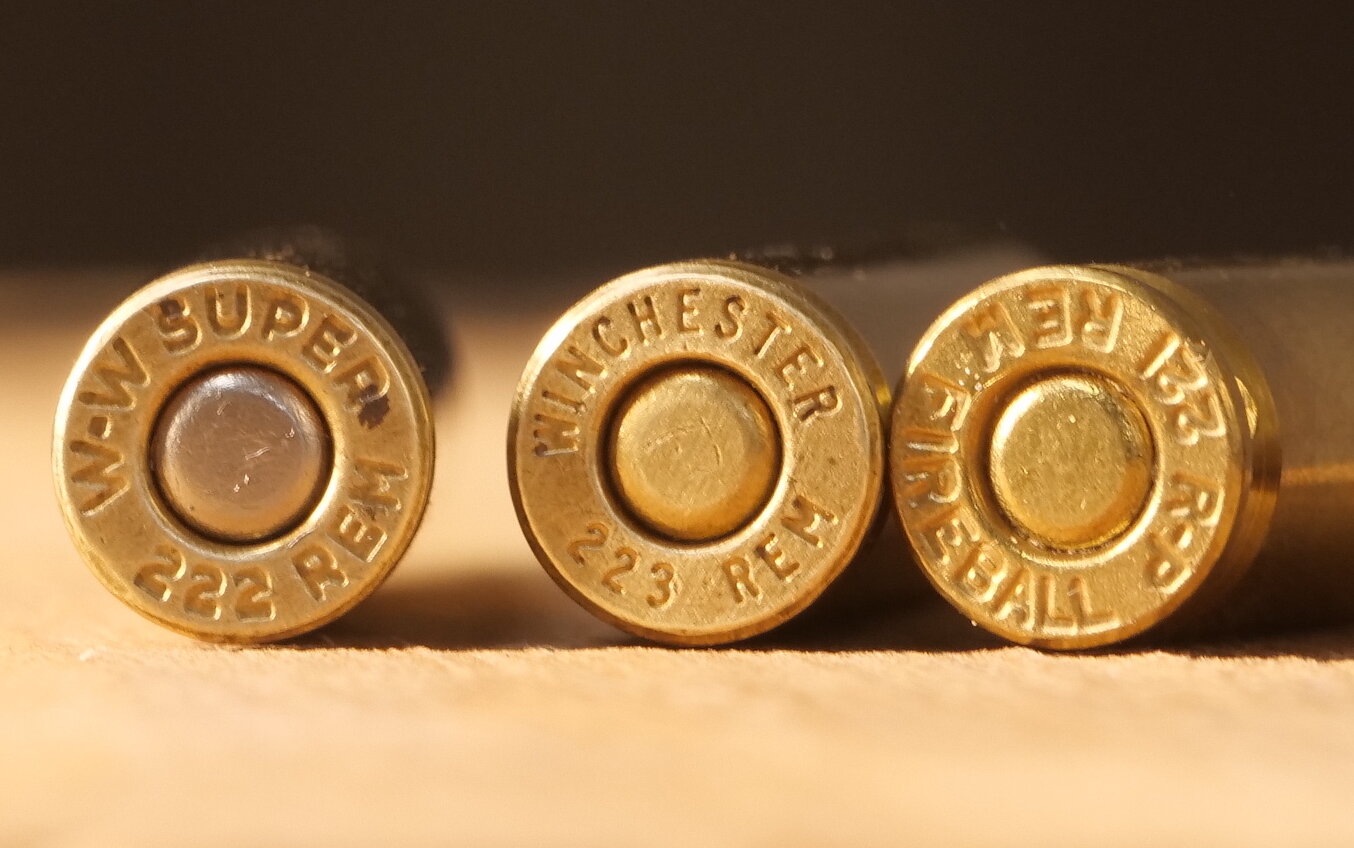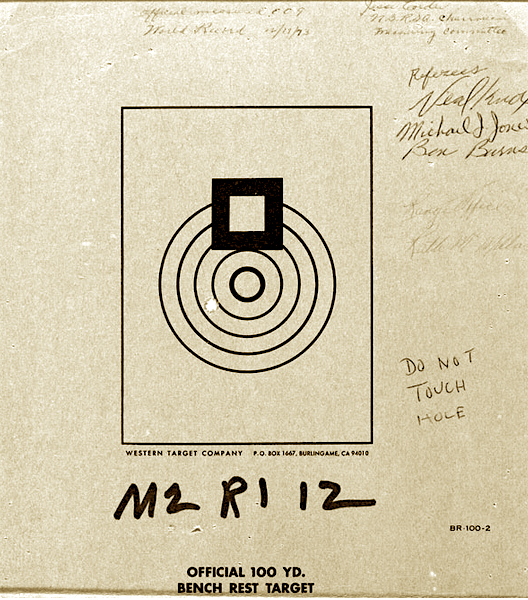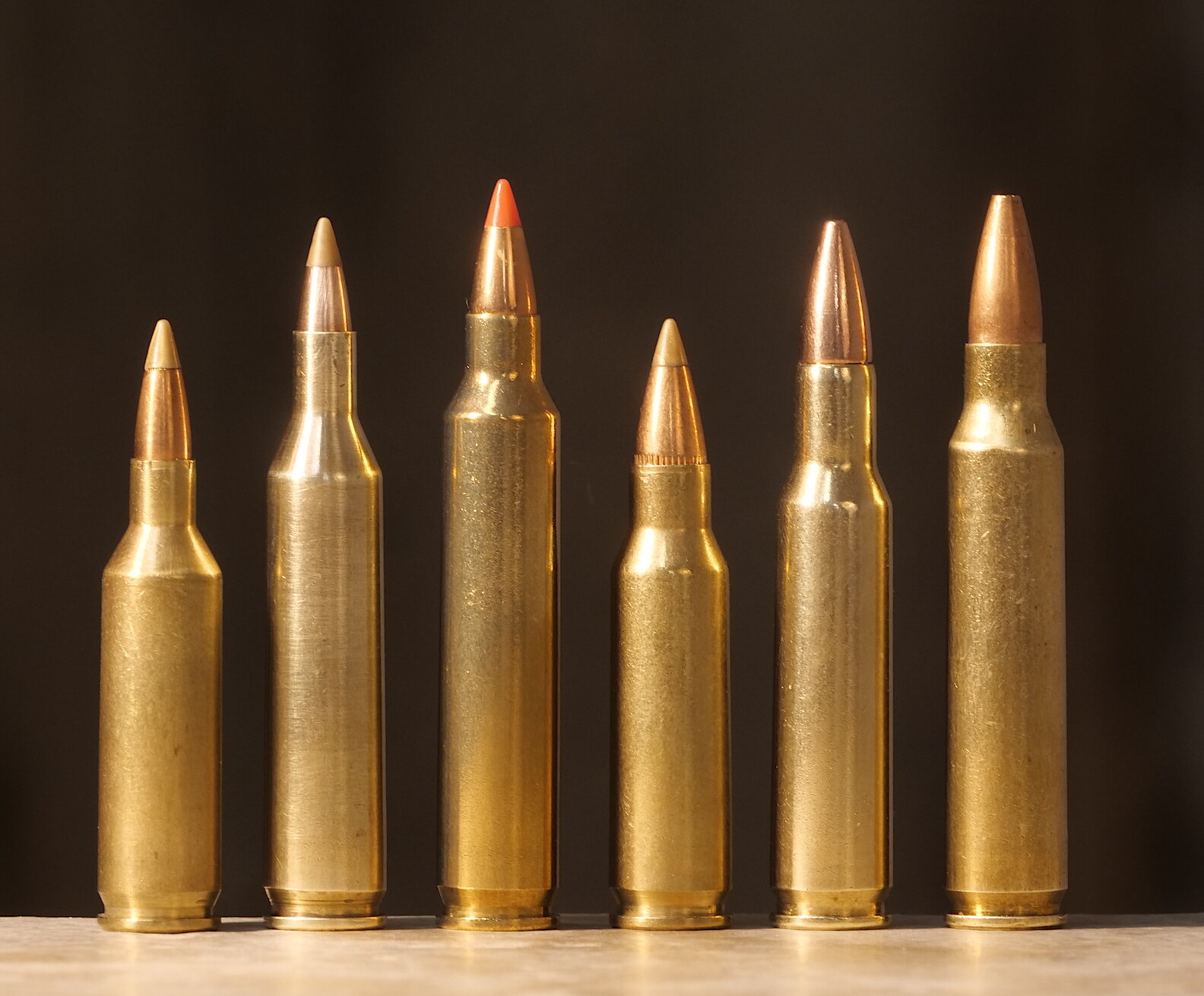Who Killed the 222 Remington?
Pity the poor 222 Remington centerfire rifle cartridge. Yesterday’s super star. Today’s forgotten star. Killed off by a heartless upstart of it's own lineage.
Image shows three 222 Remington cartridges
Seeing triple triple. Three 222 Remington cartridges triplicate the Two Two Two Triple Deuce, once the darling of 22 centerfire shooters. What went wrong?
Seriously, how many hunters or target shooters do you know who shoot the 222 Remington, let alone buy a new rifle chambered for it? Yeah. Neither do I.
Unless I can count my brother. While the rest of our gang moved on to the 223 Remington, 22-250 Remington and even 22 Nosler, Bob stuck with his tried and true Triple Deuce and Sako rifle. And he loves it.
But you, dear reader, are not brother Bob, so you might want a bit more information about this 222 Remington, aka Triple Deuce, aka Two Two Two. It was the darling varmint and target round of the 1950s and 60s. Remington engineer and National Benchrest Shooters Association co-founder Mike Walker created it and Remington released it in 1950. It was the first rimless 22 centerfire cartridge and ideally suited for bolt-action rifles like Remington’s Model 722, short-action predecessor to the M700.
Historic photo shows Mike Walker, designer of 222 Remington, at shooting bench with rifle.
Designer of the 222 Remington and benchrest shooter Mike Walker.
Well into the 1970s the 222 Remington hovered at or near the top of the benchrest shooting game, setting all kinds of records including, in 1973, the first by-golly genuine, 5-shot, one-hole group. All kinds of measurers came up with a group span of 0.0000”. A committee of NBRSA brass finally gave the target the official score of 0.0009.” That stood as the world record until 2013.
PHoto shows target of world record group shot in 1973.
This is reportedly the target shot by Mac McMillan in September, 1973, using a McMillan- built rifle chambered 222 Remington. He even made his own 50-grain bullets. A Leupold 12X target scope handled the sighting duties.
ignited by an experimental CCI primer that later became the BR-4.
The 222 didn't seriously decline on the benchrest circuit until the 22 PPC and 6mm PPC "short fat" cartridges showed up around 1973.
As a varmint round the 222 Remington was a pure delight. Just 20- to 22.5-grains of relatively fast burning powder like IMR 4198 or Hodgdon 322 would push a 50-grain bullet 3,000 to 3,200 fps from a 24” barrel. It was easy on coyote, bobcat, and fox pelts. It tipped over deer in Texas and moose in Canada, though far from ideal for either. In a seven-pound rifle recoil was a laughable 3.3 foot-pounds at a velocity of just 5.5 fps. This wasn’t a pussy cat. It was a newborn kitten. Rifles shot so smooth and easy they made you want to pour lead downrange as if were were operating a 22 Long Rifle. Fortunately, it didn’t matter much because rounds didn’t cost much more than 22 rimfire and they didn’t heat barrels so much that early burnout was a big problem. Certainly bench shooters had to watch temperatures, but predator hunters had nothing to worry about and even high volume varmint shooters could blaze away with reckless abandon.
Yellow-bellied marmot standing alert.
Marmots like this yellow-bellied western specimen, but more often its eastern cousin the woodchuck, probably inspired more 222 Remington sales than any other critter.
Of course, the little Two Two Two could fling 40-, 45-, 52-, 53-, and 55-grain bullets, too, but 50 grain spire points were about optimum. Standard rifling twist rate of 1:14 couldn’t stabilize longer bullets. But zero a sharp 50-grain, like today’s Nosler Ballistic Tip, at 225 yards and it would strike about 2 inches high at 100 yards, fall about 3 inches below line-of-sight at about 270 yards. Pretty good maximum point blank range for most fox, jackrabbit, and coyote shooting opportunities.
Bull moose are often shot by subsistence hunters in the far north with 222 Remington rounds.
A moose is not the ideal subject for a 222 Remington to address, but hundreds, perhaps thousands have been taken to the meat shed by subsistence hunters in the far north who rely on the efficient, inexpensive little Triple Deuce.
222 Remington Trajectory 50-gr. Nosler BT
Surprisingly, the 222 Remington was the first 22 centerfire with a rimless case. Until it came along, the 22 market was owned by 22 Savage Hi-Power (Imp,) 22 Hornet, 218 Bee, 219 Zipper, and 219 Donaldson Wasp. All were rimmed cases best suited for single-shots and lever-actions. Even the 220 Swift, the hyper-velocity champ since its release in 1935, was a semi-rimmed case.
With the Swift scorching the prairies at 3,700 fps with a 50-grain projectile, why would the 222 Remington gain so many fans? The 1950s and 60s, after all, were the age of speed. Jets. Rockets. Rock-and-roll. The race to space. Why would velocity-hungry American shooters settle for the little Triple Deuce? Probably because its more reasonable velocity didn’t torch barrels, didn’t break the piggy bank, didn’t require 26” barrels, didn’t ring the ears as badly as the Swift, and didn’t recoil so much that you lost the sight picture. Yet it provided more reach and accuracy than the 22 Hornet and 218 Bee.
Image shows 22 Hornet, 222 Remington, 220 Swift cartridges size comparison.
In 1950 Mike Walker's "designed from scratch" 222 Remington was the first rimless 22 centerfire and it fit nicely between the 22 Hornet and 220 Swift.
The 222 Remington can also be credited as the progenitor of several other popular rounds including the one that buried it, the 223 Remington. But first came the 222 Remington Magnum in 1958, a slightly longer version of the 222. The 223 Rem. oddly, is a slightly shorter version of the 222 Rem. Mag. developed during the same period for the Army’s new AR-15 platform rifle. Other 222 offspring include the short 221 Fireball which was later necked down to make the 17 Remington Fireball. The 223 Rem. got reconfigured into the 17 Remington, 204 Remington, and 300 Blackout. But all are based on the basic 222 Remington case.
Photo shows five cartridges that sprang from the 222 Remington.
The little 222 Remington gave rise to a significant family of cartridges. L. to R. are 17 Fireball, 17 Remington, 204 Ruger, 221 Fireball, 222 Remington, 223 Remington. Not shown are the 222 Rem. Mag. and 300 Blackout.
It is often said the 222 Remington is so nicely balanced because its a scaled down 30-06 Springfield, but that isn’t accurate. The base-to-shoulder length of the 30-06 is 5.7-times its outside neck diameter. The base-to-shoulder length of the 222 Remington is 5-times its outside neck diameter, so it’s proportionally shorter. Nevertheless, the 222 Remington is a wonderfully balanced, efficient, and friendly cartridge. An old South Dakota game warden years ago told me reloading the Triple Deuce was easy. Just scoop it full of BL-C2 and seat the bullet. (Don’t try this yourself!)
On average the 223 Rem. holds about 2.5 grains more water than the 222 Rem. when both seat 50-grain bullets. That’s good for about 200 fps more muzzle velocity, depending on the barrel. That gives the 223 Rem. about a 1.5 inch drop advantage at 300 yards. Should that be enough to consign the 222 Remington to the ash heap? Probably not. But military rounds inevitably become extremely popular due to abundance and familiarity. If you’re buying a new rifle in a mid-velocity 22, why not go with the 223 over the 222? Same cost, potential for free once-fire military brass, more options in factory ammo, and all the new AR platform rifles are already chambered for it — but not the 222 Remington. Duh.
The head size of the 222 Rem. (.378") is the foundation for many subsequent rounds like the 223 Rem. and 221 Fireball. All three shoot the same .224" bullets.
Thus did the 222 Remington, like Kings of old, waste away, overwhelmed and displaced by its descendant. Nevertheless, the old Two Two Two remains easy to load and easy to shoot. Factory ammo isn’t as variable or available as 223 fodder, but Federal, Fiocchi, Hornady, HMS, Norma, Nosler, Remington, Sellier & Bellot, and Winchester still load it. There are probably others. If you are a handloader and you find a used 222 Remington rifle in good condition at a good price, you might want to pick it up. Redding will sell you the dies and away you go.
The author, like most hunters, traded his 222 Remington for a 223 Remington years ago. He often regrets that.





















